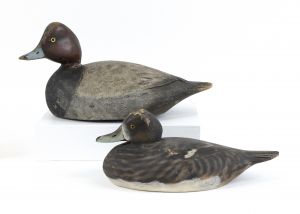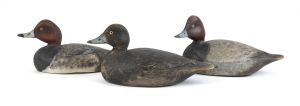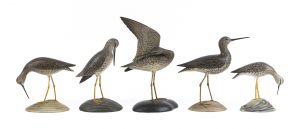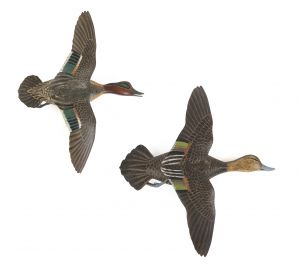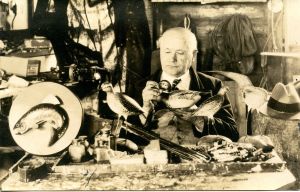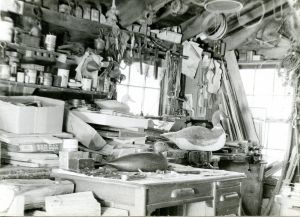The Carver Behind the Birds
By: Amanda Wastrom, Assistant Curator
A.E. Crowell. Say the name alone and it may ring a distant bell (after all, Crowell is an historic well-known Cape Cod family) but perhaps you cannot place it. For instant recognition, one must add, “you know, that famous bird carver from Harwich?” Oh yes! Many of us have vague notions of Anthony Elmer Crowell. The stories of record-breaking auction prices (into the seven digits) for decoys made by this Harwich cranberry farmer are local legend. Crowell was a master craftsman and, subsequently, one of the best American folk artists of the early 20th century.
Not surprisingly, there is more to Crowell’s story than trivia facts full of big numbers and commendations. A.E. Crowell’s full story – from the damp smell of hard wood burning in the potbellied stove to the hazy, dust-filled light to the crusty crunch of wood shavings underfoot – is much richer!
Elmer Crowell lived in a modest house that still stands on Route 39 in East Harwich. Now privately owned, the house has frequent visits from Crowell fans traveling to stand on the hallowed ground of the barn and its legendary workshop. Born in Harwich, he grew up there, lived there, worked there and died there. He is the quintessential native son.
Like most Cape Codders in the late 19th century, Anthony Elmer Crowell lived a modest life with his family and cobbled together a living doing a little of this and that. His father was a cranberry grower and Elmer continued in the family trade. From a very early age, he became immersed in the world of hunting and market gunning (the large-scale hunting/shooting of migratory fowl for commercial sales) ⎯ two activities that were thriving on Cape Cod in the late 1800s. While cranberry growing continued to be his occupation up until 1912, he was a skilled hunter and guide and often worked the seasonal gunning camps that could be found up and down the Cape and beyond.
Crowell had been whittling, carving and painting since his early 20s, mostly as a hobby. His subjects were almost exclusively those closest to his heart: hunting, birds and wildlife. His earliest known carving is a Canada goose miniature, now in the collection of the Shelburne Museum, which dates to 1894, when Crowell was 32 years old. His hobby slowly evolved into a business, as fellow hunters and friends recognized the skill of his work and began purchasing his decoys and decorative carvings. He could create whatever a client wanted. “When you bought something from Elmer, he wrote your name down in a book and wrote down what you wanted,” says noted Crowell historian Jim Parker, “next summer you came back and picked it up.” Although health difficulties prevented him from carving in his later years, Crowell continued to create until his death, with his son, Cleon, often assisting in both the carving and painting.
A colorful character complete with a collection of phrases like “Auguary,” his term for nasty weather, Crowell was known for both his warm manner and his great shot, and was beloved by fellow hunters and townspeople alike. He was a fine dancer and a wisecrack (he apparently named his barn cat “Tear Shins”). Locals remember that his barn was often a gathering spot for hunters and gamers where Elmer would hold court, sharing stories, tips, and his prodigious inventory of carvings that would line the walls and workbench of the shop. He was quick to share his knowledge with anyone interested, be they collectors or children. Parker notes, “he made birds at a lot of different levels for a lot of different people, so that everyone could have one. Elmer would make a $5 black duck for a Cape Codder but if it was a woman pulling up with a chauffeur, it would be $25.”
Crowell was not just a bird carver. Elmer Crowell’s name comes up a lot in the Harwich town reports as he held many different town positions. He was a fire warden. He was very involved in the town and the neighborhood.
Crowell is now considered the father of modern bird carving. He had a gift for blending paint on wooden objects that has been hard for anyone to duplicate. His talent and the range of his skill is evident in his miniatures, songbirds, life-sized birds and decoys. With one of the most extensive public collections of Crowell’s work, Heritage is fortunate to have examples of each of these categories – many of which will be on display this season in the Heritage Highlights exhibition in the American Art & Carousel Gallery, beginning April 23, 2022.


